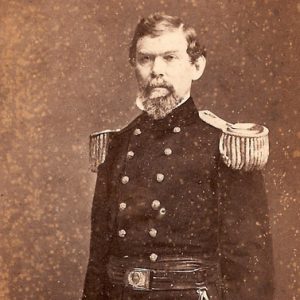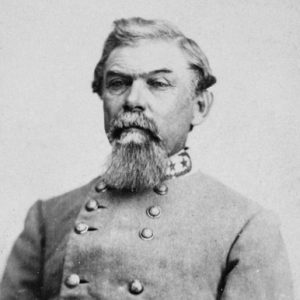calsfoundation@cals.org
William Joseph Hardee (1815–1873)
William Joseph Hardee, known as “Old Reliable,” was one of the finest corps commanders in the Confederate army. At the outbreak of the Civil War, he was the first Confederate general sent to Arkansas, where he organized a number of regiments. Hardee was already a well-known figure to officers in both armies because his manual on infantry tactics became required reading for a generation of officers during the Civil War. To quote Hardee’s biographer Nathaniel Cheairs Hughes, Jr., “It might be said that every officer of the war went into battle with a sword in one hand and a copy of Hardee’s manual in the other.”
William Hardee was born on October 12, 1815, in Camden County, Georgia, the youngest of seven children of John Hardee and Sarah Ellis Hardee. His father was a prominent citizen of Camden County, a state senator and slaveholder with a 1,300-acre plantation. Hardee was accepted to the United States Military Academy in 1834. He graduated in 1838 with an undistinguished academic record, ranking twenty-sixth out of a graduating class of forty five. After graduation, Hardee served in the Second Seminole War (1836–1843). He married Elizabeth Dummett on November 16, 1840. She died of tuberculosis in 1853.
Prior to the Mexican War, Hardee, as part of Zachary Taylor’s “Army of Occupation,” was captured in a skirmish at the Carricitos ranch on April 25, 1846. Later released as part of a prisoner exchange, Hardee found that his command decisions at Carricitos came under question. Though exonerated of any wrongdoing by a court of inquiry, Hardee was determined to clear his tarnished reputation in combat. He served honorably in a number of actions and was brevetted twice for gallantry during Winfield Scott’s campaign to capture Mexico City.
Hardee emerged from the Mexican War a minor war hero whose exploits gained the attention of Secretary of War Jefferson Davis. Davis chose Hardee to write a new infantry tactics manual for the American army. This manual recognized recent military developments, the most important being the Minie bullet, which had far greater range and accuracy than the musket ball. Hardee’s Rifle and Light Infantry Tactics was completed in 1855 and became the standard textbook for Union and Confederate officers during the Civil War. In 1856, Davis appointed Hardee commandant of cadets at the United States Military Academy. As commandant until 1860, Hardee earned a reputation as a firm disciplinarian under whose guidance many future officers gained distinction in the Civil War.
After Georgia seceded from the Union, Hardee resigned his commission and joined the Confederate army. He was appointed brigadier general on June 17, 1861, and received a command in northeastern Arkansas. Based at Pitman’s Ferry, he organized a number of Arkansas regiments. Hardee’s task of recruiting Arkansas state troops to the Confederacy was difficult because officers feared loss of rank if incorporated into the Confederate army, and many soldiers believed that they would be sent east, leaving Arkansas undefended. To help with recruiting, Hardee enlisted the aid of the popular and politically influential Thomas Hindman, who succeeded in saving a significant number of soldiers for the Confederacy. The Arkansas recruits were an odd mixture: the Ninth Arkansas was known as the “regiment of preachers” because it contained a number of frontier ministers, while one company containing many raucous Irishmen was dubbed the “Shamrock Guards.” Hardee, an able drillmaster, molded the rough Arkansas recruits into fine soldiers. He was promoted to major general and given command of a division on October 21, 1861. The division, which would become one of the most famed in the Army of Tennessee, was composed primarily of Arkansans, with eight of the division’s eleven regiments from Arkansas. To instill loyalty, Hardee designed a unique flag for the division. The flag contained a blue field with a silver moon in the center. Hardee’s division (later Patrick Cleburne’s) was the only one in the Confederacy officially permitted to carry a flag other than the traditional Confederate battle flag into battle.
Hardee and his division joined Albert Johnston’s newly created Army of the Mississippi in March 1862. Hardee commanded a corps at the Battle of Shiloh on April 6, 1862, where he was slightly wounded. He was then transferred to Braxton Bragg’s Army of Tennessee. Hardee fought at most of the Army’s major battles, including Perryville, Kentucky; Murfreesboro, Tennessee (regarded as Hardee’s finest battle); and Chattanooga, Tennessee. Hardee was promoted to lieutenant general on October 10, 1862. Following the defeat at Chattanooga, Bragg was relieved of command, and Hardee temporarily took charge of the Army of Tennessee in December 1863. Hardee declined permanent command of the Army because he believed his abilities were better suited to that of a corps commander. He also appears to have wanted to take a short-term leave of absence in order to marry his second wife, Mary Lewis, the daughter of a plantation owner.
Hardee served in the Atlanta campaign under the Army’s new commander, Joseph E. Johnston. When Jefferson Davis lost patience with Johnston’s defensive tactics, he replaced him with the aggressive John Bell Hood. Hardee became convinced that Hood was unsuited to army command. After the Battle of Jonesboro in Georgia, Hardee requested a transfer and, in September 1864, assumed command of the Department of South Carolina, Georgia, and Florida, where he helped oppose Sherman’s March to the Sea. Hopelessly outnumbered, Hardee’s men successfully evacuated Savannah, Georgia, in December 1864. Hardee opposed Sherman’s Carolinas campaign but finally surrendered at Archdale, North Carolina, on April 26, 1865.
After the war, Hardee managed his wife’s two plantations near Demopolis, Alabama. In February 1866, Hardee moved to Selma, Alabama, to take the position of president of the Selma and Meridian Railroad, which he held until 1868. While on an annual trip north to escape the summer heat, Hardee fell ill and died in Wytheville, Virginia, on November 6, 1873. He is buried in Selma.
For additional information:
Hughes, Nathaniel Cheairs, Jr. General William J. Hardee: Old Reliable. Baton Rouge: Louisiana State University Press: 1992.
———. “Hardee’s Defense of Savannah.” Georgia Historical Quarterly 47 (March 1963): 43–67.
Warner, Ezra J. Generals in Gray: Lives of the Confederate Commanders. Baton Rouge: Louisiana State University Press: 1959.
Clement Mulloy
Arkansas State University–Mountain Home
 William Joseph Hardee
William Joseph Hardee  William J. Hardee
William J. Hardee 



As a lay person working on a book involving Civil War family members, I’ve found Encyclopedia of Arkansas uniformly fair and clear and enormously helpful–this entry included. My thanks to Clement Mulloy and all contributors.